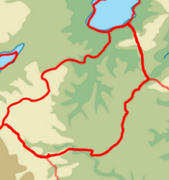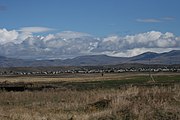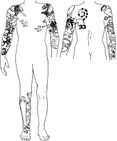Hacyinia: Difference between revisions
| Line 179: | Line 179: | ||
|caption = | |caption = | ||
}} | }} | ||
The Thin Air Sect of Badism is the most followed religion in the country, as well as the most widespread. Irfan is typically followed in the mountain and hilly areas along the border of Zorasan, while the Pure Water Sect of Badi is almost exclusively centered in urban areas around Lake Zinarud. | |||
=== Ethnicity === | === Ethnicity === | ||
| Line 185: | Line 187: | ||
| caption= <small>Ethnicity in Hacyinia</small> | | caption= <small>Ethnicity in Hacyinia</small> | ||
| label1 = {{wp|Azerbaijanis|Bulaqs}} | | label1 = {{wp|Azerbaijanis|Bulaqs}} | ||
| value1 = | | value1 = 35 | ||
| label2 = {{wp|Tajiks|Sagartians}} | | label2 = {{wp|Tajiks|Sagartians}} | ||
| value2 = 20 | | value2 = 20 | ||
| Line 192: | Line 194: | ||
| label4 = {{wp|Mongolians|Ukilen}} | | label4 = {{wp|Mongolians|Ukilen}} | ||
| value4 = 11 | | value4 = 11 | ||
| | | label6 = {{wp|Bamar people|Chanwan}} | ||
| | | value6 = 7 | ||
| | | label5 = Others | ||
| | | value5 = 12 | ||
| other = | | other = | ||
| other-color = | | other-color = | ||
Revision as of 17:15, 2 February 2023
This article is incomplete because it is pending further input from participants, or it is a work-in-progress by one author. Please comment on this article's talk page to share your input, comments and questions. Note: To contribute to this article, you may need to seek help from the author(s) of this page. |
Hacyinia Khanate | |
|---|---|
 Location of Hacyinia on Kylaris in dark green | |
| Capital and largest city | Dabulug |
| Recognised national languages | Pardarian, Gaullican |
| Recognised regional languages | Dehgan, Oroqmen, Ziba, Majgar, Ukilen |
| Other languages | Chanwan |
| Demonym(s) | Hacyinian |
| Government | Unitary unicameral semi-constitutional monarchy |
• Khan | Makbule Arda Khan |
• Prime Minister | Zhandos Bekbolat |
| Legislature | The Kurultai |
| Establishment | |
• Ashina Empire | 50 BCE |
• !EasternSteppeKhagnate | ~1000s/1100s CE |
• Bessharian Khanate established | 1789 |
• Formation of the Hacyinian Khanate after incorporating xxx and xxx | 1845 |
• Establishment of the Kingdom of Hacyinia | 1935 |
| Area | |
• Total | 1,031,116.801 km2 (398,116.423 sq mi) |
| Population | |
• 2022 census | |
• Density | 27.2/km2 (70.4/sq mi) |
| GDP (PPP) | 2022 estimate |
• Total | $381.74 billion (50th) |
• Per capita | $13,611 (59th) |
| GDP (nominal) | 2022 estimate |
• Total | $167.49 billion (44th) |
• Per capita | $5,972 (52nd) |
| Gini | 41.9 medium |
| HDI (2022) | 0.654 medium |
| Currency | Hacyinian som |
| Date format | dd-mm-yyyy |
| Driving side | right |
| Internet TLD | .ha |
Hacyinia, officially known as the Hacyinia Khanate, is a country in Coius. It borders Dezevau and Lavana to the east, Zorasan to the north and west, Shangea to the southwest, and Zomia to south. A landlocked country, it is the eastern edge of the Great Steppe and the vast majority of the country falls within the delineation of the Great Steppe. Hacyinia straddles the boundary between Southeast Coius and Greater Pardarian physically and culturally. The 31st largest country, Hacyinia occupies 1,031,116.80 km2. The 28 million citizens are multi ethnic, multi lingual and multi religious, who can trace their heritage from the mosaic of nomadic and settled peoples that have influenced the countries history. Population-wise, Hacyinia is roughly the xxx most populous country in the world.
Hacyinia and Lavana has been engaged in a longstanding border conflict over the Yoloten region since the 1940s
Etymology
Hacyinia (Pronounced: /hɑ:sin.i.ə/, Listen) comes from the Old Pardarian word "hamicyia", meaning rebellious. The name originally comes from the nickname given to an Oroqic chieftain by the Arasanid Empire who perpetually continued to rebel and fight against Arasanid rule. Hacyinia eventually morphed into the name of the general steppe region between the Pardaric and Ziban politys, and remained as a placename until the establishment of the Hacyinian Khanate in 1845 where it then transferred to being the political name of the area as well.
History
Hacyinia has a long history, dominated mostly by the nomadic peoples that have ruled from the steppes as well as powerful empires who have conquered and held sway over the area. Although the area has long been inhabited with archeological records showing evidence of human settlement dating back to 6,000 BCE; the first recorded peoples in the area date back to the second millennia B.C with !Scythian/!Saka nomads domaining the steppes and settled Pardardian speaking city states establishing themselves in the eastern river deltas by Lake Zinabad, as well as in the foothills of the western mountains. The Chanwan had long called the highlands of western Hacyinia home and began establishing their own polity's in the highlands of the Huashan mountain range. In the southwestern steppe, in the modern day borderlands between Hacyinia, Zomia and Lavana, the proto-Oroqic Ashina held sway and competed with the !Scythians/!Saka for control of the steppe. The Ashina were able to establish several of their own powerful states controlling parts of Southeast Coius until just before the end of the 1st century CE.
Great War
Attacked Gaullican colonies during the later stages of the Great War (!Third Anglo-Afghan War), influential later arrival to the Grand Alliance in their region.
Post Great War
Supported Estmere during their occupation of SE Coius. Likely saw eastern Hacyinia fold into country during this time during Estmere supported negotiations. Began fancying itself as a regional power, imposed self on the majority Oroqic and Ukilenic lands of eastern Lavana which has led to massive amounts of conflict. Spent a good chunk of the post war years bouncing between Senria and Shangea in order to gain resources/support, more closely aligned self with Shangea as time progressed.
Friendly with the Pardarian Revolutionary Resistance Command - the Shah had designs to take over parts of Hacyinia prior to the civil war/other beefs between Hacyinia and the Shah, saw an oppertunity to remove him and supported Zorasan ever since
Occupied large bits of western Lavana/"Outer Hacyinia" for a bit following the great war, refused to give the land back to the newly formed Lav Republic - got booted off when Lav socialists came to power. Considers much of the traditional Oroqic/Ukilenic land in Lavana to be "rightfully" Hacyinian.
Present Day
Struggling against Lavana due to the Yoloten, wider conflict against the SE Coius Councilst Bloc due to this. Incresingly closer to Zorasan/ROSPO during this time
Geography
Photograph of the central steppe with a ger district in the background
- Haraz river.jpg
Photograph of the river deltas of Karasm
At 1,031,116.80 km2, Hacyinia is the 15th largest in Coius, and the 31st largest in the world. It is slightly smaller than Behera and slightly larger than Belmonte. A landlocked country, it has a minimally varied terrain. The country is overwhelmingly steppe land. In the west there is the Transhuashan foothills and the plateau of the Great Steppe, while in the east there is the riparian inflowing rivers deltas to Lake Zinabad. The elevation of the country varies greatly however, with some areas being several thousand meters above sea levels and others being several hundred meters below sea levels. Generally elevation rises the in the west and closer to the Huashan mountains. The country is entirely considered to be within a Temperate grasslands, savannas, and shrublands biome, with a temperate climate. Precipitation is fairly high, and generally there is mild winters with warmer summers. The increasing desertification of nearby Zorasan has had a major impact on eastern Hacyinia in particularly, with notable land degradation impacting the agricultural output of eastern Hacyinia.
Arable land is at a minimum and mostly of the countries arable land is concreated in the east along in the river deltas and the shore of Lake Zinabad, or more limitedly in the west in mountain oases supplied by the melting glacial water of the Huashan mountains. The central steppes soil is incapable of supporting any sort of large scale agriculture, although it is more than capable of supporting large scale animal husbandry both historically and modern day. Much of the steppe has very limited water supply sans a few lakes and seasonal rivers that occasionally form. Water rights is a serious political concern, both domestically as well as internationally. Much of the water resources in the country are located in Karasm and are used to support extensive commercial agriculture. The shrinking of Lake Zinabad is of great concern to the Hacyinian government, and the Karasmic government before that.
The country is also periodically struck by zuds, which are occasional and harsh sudden changes in the climate which causes a large amount of livestock to die due to starvation, the elements and other factors. It does cause an extensive amount of economic and social upheaval for the predominantly rural, pastoral population as they are forced to move to urban areas or abroad in order to find work. Zud's are becoming increasingly more common as climate change and desertification impact the country.
Wildlife
Bactarian deer! Bactarian camels! Wolves! There's brown bears in Central Asia apparently? Snow leopards, cut & paste from stuff. Horses!
Demographics
Religion
The Thin Air Sect of Badism is the most followed religion in the country, as well as the most widespread. Irfan is typically followed in the mountain and hilly areas along the border of Zorasan, while the Pure Water Sect of Badi is almost exclusively centered in urban areas around Lake Zinarud.
Ethnicity
Ethnicity in Hacyinia
Government and Politics
https://iranicaonline.org/articles/central-asia-vi
State gangsterism
Economy
10h largest oil producer in the world (1,229,357 bbls per day), wealth of mineral resources. Other major exports include cotton and livestock. The economy is buoyed by being surrounded by larger, wealthier and stabler states. However, as a landlocked country, it's economy is also hindered by it's lack of natural sea access. It's wholly reliant on shipping it's goods through xxx because of political circumstances, and any freeze in relations would tank the economy.
Hacyinia is incredibly rich in mineral resources. Hacyinia ranks amongst the top nations for both production and reserves in uranium, coal, gold, tin, tungsten, cooper, bauxite, chromite amongst others. Most of the mineral resources are located in the countries west. Ninja miners often operate on the far western reaches of the country or along the border with Zomia.
Hydroelectricity is an important sector of the economy. Several major rivers in the country, flowing towards Lavana - several large scale dams/projects built in order to capture the hydroelectric power of the country as well as to free up oil/natural gas resources for market. Dams also utilized as a bargaining chip in Lavana - Hacyinia maintains an ability to impact a fairly significant % of Lavana's water supply.
Agriculture is divided into two parts. The first is nomadic or semi-nomadic animal husbandry, which constitutes roughly 58% of the agricultural output of the country. Major animal products exported by Hacyinia include meat and fat from camels, cattle, chickens, horses, goats, pigs and sheep; eggs; honey; milk; wool from camels, cattle, goats, and sheep; and hides and skins from camels, cattle, goats, horses, and sheep. The other 42% of the agricultural sector in Hacyinia is crop-based farming. Cotton is referred to as "white gold" in Hacyinia. Introduced by the Gaullicans, massive plantations were set up in eligible areas. Commercial growing of cotton spread throughout Hacyinia, and currently now operates as a massive cash crop for the country. Most agricultural in the country is concreated in areas closer to Lake Zinarud, or, along heavily irrigated rivers in the countries west.
Culture
Sport
Kokpar very popular, as well as other equestrian games/activities owing to countries steppe and horse culture. Mongolian wrestling/Turkic wrestling also popular. Something like Naadam very possible. Rugby, in the union/league/sevens variants, is the most common team sport in the country followed by basketball. Combat sports/martial arts also very popular.
Cuisine
Due to influence from neighboring Dezevau, ganome's are ubiquitous throughout the country. Hacyinia has a strong coffee culture.
Tattoos
Hacyinia has a rich history of tattooing. Various cultures in modern Hacyinia has practiced forms of tattooing throughout their history, and today its fairly common to see tattoos adorned on most people in Hacyinia. Despite the different styles of tattoos, almost all are rooted in beliefs that the tattoos are useful as charms to ward off evil spirts or to bring good luck to the tattooed person. Tattoos are typically more common in the western side of the country, as during the Gaullican colonization period the colonial authorities attempted to end the practice amongst various ethnic groups - albeit the practice continued in secret.
Historically, the Central Coian trade route and the Great Steppe trade routes helped spread the influence of Hacyinian tattoos across Coius.

















